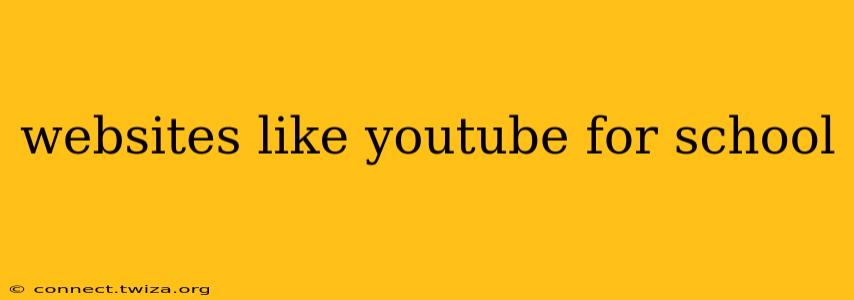YouTube is a ubiquitous platform, but its vast, uncurated content isn't always ideal for the classroom. Teachers and students alike need safe, reliable resources for educational videos. Fortunately, many excellent alternatives exist, catering to various learning styles and subject matters. This guide explores several websites like YouTube for school, highlighting their strengths and differentiating features.
What Makes a Good Educational Video Platform?
Before diving into specific websites, let's establish what constitutes a strong educational video platform. Key features include:
- Curated Content: A carefully selected library of videos, ensuring age-appropriateness and educational value.
- Organized Structure: Easy navigation and search functionality to quickly locate relevant resources.
- Teacher Resources: Tools and support for educators to integrate videos into lesson plans.
- Interactive Features: Quizzes, assignments, and other interactive elements to enhance engagement.
- Safety and Privacy: Robust security measures to protect students' privacy and filter inappropriate content.
Websites Like YouTube for School: Top Alternatives
Here are some top contenders offering features that surpass YouTube's capabilities in an educational setting:
1. Khan Academy
Khan Academy is a non-profit educational organization providing free online courses and videos covering a vast range of subjects, from math and science to history and art. Its structured curriculum, aligned with educational standards, makes it a valuable resource for both students and teachers.
Strengths: Comprehensive curriculum, aligned with educational standards, free access, excellent search functionality.
2. PBS LearningMedia
PBS LearningMedia offers a rich collection of videos, interactives, and lesson plans aligned with Common Core State Standards. It boasts high-quality content from trusted sources, making it a reliable option for educators.
Strengths: High-quality videos, alignment with educational standards, lesson plan integration, diverse subject matter.
3. National Geographic Kids
While not solely an educational video platform, National Geographic Kids provides engaging and informative videos suitable for younger learners. Its focus on science, nature, and exploration makes it captivating for curious minds.
Strengths: Engaging content, age-appropriate for younger students, visually stunning videos, inspires curiosity.
4. TED-Ed
TED-Ed curates animated educational videos on various topics, presenting complex ideas in an engaging and accessible manner. Its visually appealing format makes learning enjoyable and memorable.
Strengths: Engaging animation style, simplifies complex concepts, diverse topics, sparks critical thinking.
5. Vimeo Education
Vimeo Education provides a platform for educators to share and discover high-quality educational videos. Its focus on professional content and community building makes it an excellent resource for collaboration and sharing best practices.
Strengths: High-quality video hosting, community features, supports educators sharing resources, advanced analytics.
6. Crash Course
Crash Course offers a series of YouTube channels covering a wide variety of topics, explained in engaging and informative ways. While on YouTube, its curated nature and focus on education make it worthy of inclusion.
Strengths: In-depth explanations, engaging presenters, covers a wide range of subjects, accessible on YouTube.
Frequently Asked Questions (FAQs)
H2: What are the best educational video platforms for elementary school students?
For elementary students, platforms like National Geographic Kids, PBS LearningMedia (with age-appropriate filters applied), and Khan Academy (with its early learning sections) are excellent choices. Their engaging visuals and simplified explanations cater well to younger learners.
H2: Are these platforms free to use?
Most of these platforms offer free access to their resources, although some might require subscriptions for premium features or access to specific content. Check the individual websites for details on pricing and availability.
H2: How can I integrate these websites into my classroom lessons?
Many platforms provide lesson plans and teacher guides to help integrate their resources into your curriculum. You can also use videos as introductions, discussion starters, or assessments, adapting them to fit your teaching style and students' learning needs.
H2: What safety measures are in place on these platforms?
These platforms typically employ age-appropriate content filters and other safety measures to ensure a secure learning environment. Check individual websites for details on their safety and privacy policies.
By exploring these alternatives to YouTube, educators can create a more enriching and secure learning experience for their students, ensuring access to high-quality educational videos that stimulate learning and engagement. Remember to always preview content before sharing it with your students to guarantee alignment with your curriculum and age appropriateness.
